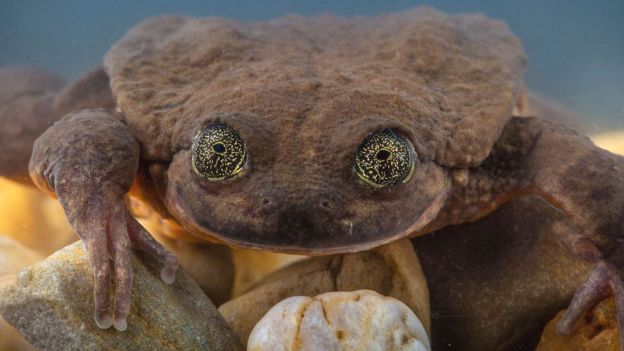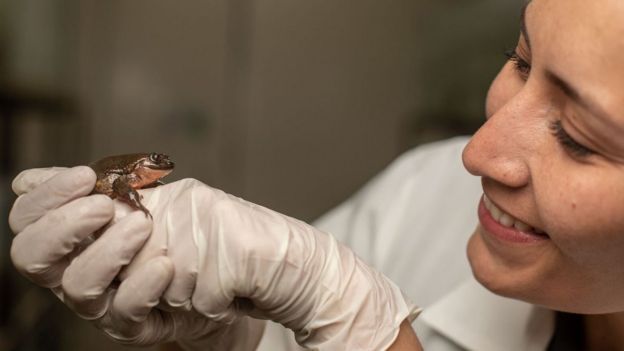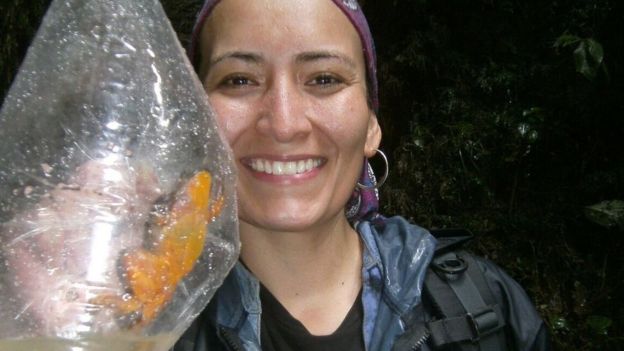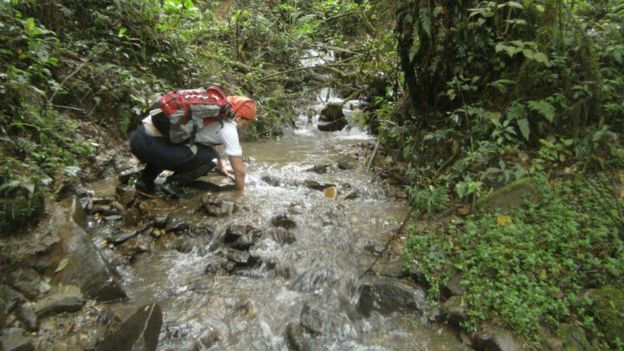A frog believed to be the last of his kind in the world has been granted a reprieve from solitude.
Romeo, known as the world's loneliest frog, has gone through 10 years in separation at an aquarium in Bolivia.
Researchers state they have discovered him a Juliet after an endeavor to remote Bolivian cloud timberland.
Five Sehuencas water frogs found in a stream were caught, with the objective of rearing and re-bringing the creatures of land and water over into nature.
Teresa Camacho Badani is head of herpetology at the Museo de Historia Natural Alcide d'Orbigny in Cochabamba City and the campaign chief.
She is idealistic that alternate extremes will draw in, even in frogs: "Romeo is truly quiet and loose and doesn't move a mess," she revealed to BBC News. "He's sound and likes to eat, however, he is somewhat bashful and moderate."

Picture copyrightROBIN MOORE, GLOBAL WILDLIFE CONSERVATION
Juliet: A female Sehuencas water frog
Juliet, in any case, has an altogether different identity. "She's extremely fiery, she swims a ton and she eats a ton and some of the time she endeavors to get away."
The five frogs - three guys and two females - are the first Sehuencas water frogs to be found in the wild for 10 years, in spite of past quests in the Bolivian wild.
Romeo was gathered 10 years prior when scholars realized the species was in a bad position, however, was not expected to stay alone for such a long time.
He pulled in worldwide consideration a year back over his scan for a mate and was even given a dating profile.
The newfound frogs are currently in isolate at the historical center's protection focus, where the race is on to prevent the species from getting to be wiped out.

Picture copyright: ROBIN MOORE, GLOBAL WILDLIFE CONSERVATION
Juliet with Teresa Camacho Badani
Sehuencas water frog: The facts
- An amphibian frog (Telmatobius yuracare) that was once bottomless in the little streams, waterways, and lakes of the montane cloud backwoods of Bolivia
- Water frogs are declining quickly in Bolivia, Ecuador, and Peru
- They face a mix of dangers, including environmental change, natural surroundings decimation and the presentation of obtrusive trout
---------------------------------------------------------------------------------
Chris Jordan of Global Wildlife Conservation, which is supporting preservation endeavors, said there is a hazard to bringing creatures into bondage.
In any case, there are excessively few of the frogs in the wild to keep up a practical populace in the long haul, he said.
"We have a genuine opportunity to spare the Sehuencas water frog - reestablishing a one of a kind piece of the assorted variety of life that is the establishment of Bolivia's woodlands, and creating essential data on the best way to reestablish comparable species at grave danger of annihilation."

Picture copyrightSTEPHANE KNOLL, MUSEO DE HISTORIA NATURAL ALCIDE D
More frogs were found on an expedition
The re-found frogs will be blessed to receive ensure against an irresistible infection, chytridiomycosis, which is clearing out creatures of land and water far and wide.
Romeo will at that point meet Juliet, trying to deliver posterity that can, in the end, be returned to their regular environment.
In Bolivia, 22% of land and water proficient species face some level of annihilation risk, from natural surroundings misfortune, contamination, and environmental change.

Picture copyright: STEPHANE KNOLL, MUSEO DE HISTORIA NATURAL ALCIDE D
Teresa Camacho Badani says Romeo's story is imperative to attract regard for the situation of creatures of land and water.
They didn't locate some other water frogs in nearby streams, bringing up stressing issues over the soundness of the biological community.
"It's a great chance to utilize Romeo to help comprehend those dangers, help see how to bring those species once more from the edge yet additionally in the meantime to exploit the worldwide profile that Romeo and his species has now," she said.
Different creatures of land and water, for example, the Mallorcan birthing specialist amphibian in Spain and the Kihansi shower frog of Tanzania have been reproduced and reintroduced from only a couple of people before.
"They give trust with regards to this 6th mass termination that there are answers for keep up our awesome biodiversity, to secure imperiled and even wiped out in-the-wild species and bring them back and reestablish a portion of the excellence of these environments," said Chris Jordan.
All species are vital and ought not to be disparaged as their DNA speaks to a large number of long stretches of advancement, he included.
Source: BBC
Source: BBC


No comments:
Post a Comment
Paste Your Website and Article Link To Create Do-Follow Backlink